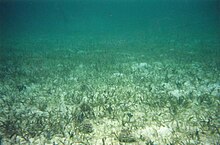Thalassia testudinum
|
Thalassia testudinum Temporal range: Middle Eocene–Present |
|
|---|---|
 |
|
| Turtle grass meadow with sea urchins Tripneustes ventricosus | |
| Scientific classification | |
| Kingdom: | Plantae |
| (unranked): | Angiosperms |
| (unranked): | Monocots |
| Order: | Alismatales |
| Family: | Hydrocharitaceae |
| Genus: | Thalassia |
| Species: | T. testudinum |
| Binomial name | |
|
Thalassia testudinum Banks ex König |
|
Thalassia testudinum, commonly known as turtlegrass, is a species of marine seagrass. It forms meadows in shallow sandy or muddy locations in the Caribbean Sea and the Gulf of Mexico.
Thalassia testudinum is a perennial grass growing from a long, jointed rhizome that may be buried 25 centimetres (9.8 in) deep in the substrate but is more usually found 5 to 10 cm (2 to 4 in) below the surface. Some nodes are leafless but others bear a tuft of several erect, linear leaf blades. These are up to 30 centimetres (12 in) long and 2 cm (0.8 in) wide and have rounded tips. The flowers grow on short stalks in the axils of the leaves and are greenish-white, sometimes tinged pink, and are followed by seed pods.
Turtle grass is found growing in meadows in calm shallow waters throughout the Caribbean Sea and the Gulf of Mexico and as far north as Cape Canaveral in Florida. Extensive meadows can be formed on muddy sand, coarse sandy and clayey seabeds, especially those with a calcareous content. This grass favours high-salinity waters with low turbidity such as calm lagoons. It cannot grow in fresh water but some growth is possible at a salinity of 10 parts per thousand. The plant's preferred range is 25 to 38.5 parts per thousand with a temperature range of 20 to 30 °C (68 to 86 °F). It is found from low-tide mark down to depths of 30 metres (98 ft) depending on water clarity. It often grows in meadows with other seagrasses where it is the climax species.
Turtle grass can reproduce both vegetatively and by sexual reproduction. The main propagative method is by increase in length of the rhizomes. This mainly takes place in spring and early summer but can happen at any time of year and results in an increase in the size of the turtle grass bed. It has been found that where plants have been damaged mechanically, such as by the propellers of boats, the cut ends of rhizomes are unable to grow and holes may develop in the turtle grass meadow.
...
Wikipedia
